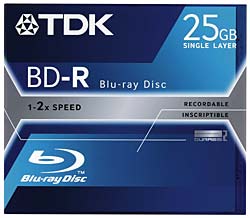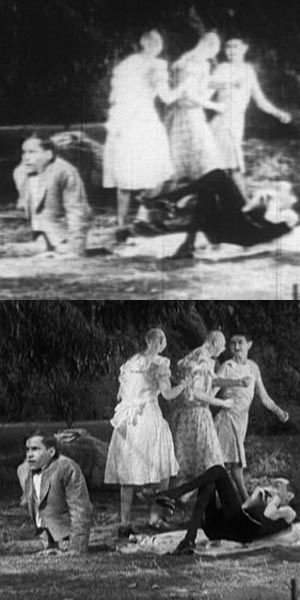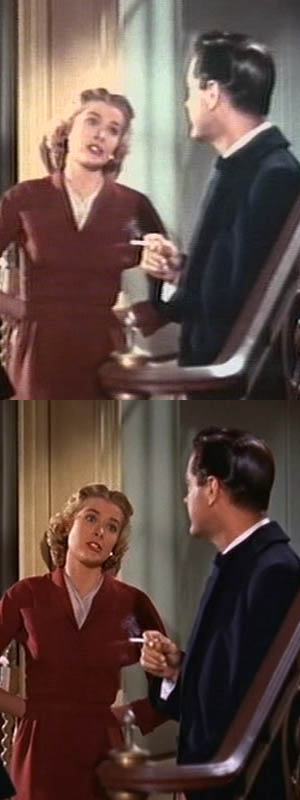Home Entertainment Blog Archive
Brought to you by your friendly, opinionated, Home Entertainment and Technology writer, Stephen DawsonHere I report, discuss, whinge or argue on matters related to high fidelity, home entertainment equipment and the discs and signals that feed them. Since this Blog is hand-coded (I like TextPad), there are no comments facilities. But feel free to email me at scdawson [at] hifi-writer.com. I will try to respond, either personally or by posting here emails I consider of interest. I shall assume that emails sent to me here can be freely posted by me unless you state otherwise.
This archive is for an uncertain period commencing Thursday, 7 December 2005
TDK has commencing shipping recordable Blu-ray discs. Its initial two offerings are a 25GB BD-R (Blu-ray Disc Recordable) and a 25GB BD-RE (Rewritable - so why not 'RW'?) Australian
US prices will be
$US19.99 and
$US24.99 respectively.
 Clearly, that's pretty pricey, but who can remember the cost of DVD-R discs when they first appeared? I seem to recall that they were around $AUS15 each. Now, buying a quality brand like TDK on spindles, they cost under a dollar each.
Clearly, that's pretty pricey, but who can remember the cost of DVD-R discs when they first appeared? I seem to recall that they were around $AUS15 each. Now, buying a quality brand like TDK on spindles, they cost under a dollar each.
Anyway, if you consider that one 25GB BD has more than five times the capacity of a single layer DVD-R, they don't seem so expensive.
This release isn't the end of the story. The Blu-ray specification provides for multiple data layers, so later this year TDK will be releasing dual layer 50GB versions of both the recordable and rewritable discs (priced $US47.99 and $US59.99). That's interesting. There are still not rewritable dual layer DVD+/-RWs available, and I suspect there never will be now. The rewritable discs are said to be good for at least 10,000 rewrites and TDK puts the archival life of both kinds at fifty years.
The discs are cartridge free, and because the transparent layer on them is only 0.1mm instead of the 0.6mm of DVDs, CDs and HD-DVDs, it has developed a harder surface coating, which it says is 100 times more resistant to scratches than the normal covering.
As to higher capacities, the company has developed a quad layer 100GB version and is currently working on an eight layer 200GB one.
UPDATE (Tuesday, 11 April 2006, 3:45 pm): Whoops. The media release apparently emanated from the US, so the discs won't be appearing in Australia for a couple of months yet, and as the above is US pricing, they will no doubt cost more in Australian dollars. I've edited the above slightly to correct this. Strikeouts and reds show the changes.
Interlacing is becoming an important matter these days. Why? Because our TV screens are getting bigger, so the problems it can cause are becoming far more obvious.
 So what is interlacing? Back in the early days of TV, the engineers made a sensible decision to save on broadcasting space. Our TV pictures consume the space required for 625 horizontal lines (576 to 585 viewable). Because our power system provided voltage that alternates positive and negative fifty times per second, the TV broadcast system was locked to this (the US uses a 60 hertz system, which partly explains its different TV system).
So what is interlacing? Back in the early days of TV, the engineers made a sensible decision to save on broadcasting space. Our TV pictures consume the space required for 625 horizontal lines (576 to 585 viewable). Because our power system provided voltage that alternates positive and negative fifty times per second, the TV broadcast system was locked to this (the US uses a 60 hertz system, which partly explains its different TV system).
But sending 625 lines fifty times a second wouldn't leave room for many TV stations. So only half the lines are sent each time. You get the full 625 lines, but only 25 times per second.
The TV station doesn't send the first 312 lines, then the second 312 lines. Instead, it sends the first, third, fifth and so on lines, then the second, fourth, and sixth etc. An old fashioned TV would display them in the same order, and typically the second line would be displayed before the first and third, above and below it, faded. All was well.
Unless there is movement in what is being displayed, which is most of the time. Video cameras mostly work the same. They record the first, third etc lines, then one fiftieth of a second later they record the second, fourth etc lines. If your favourite soap star is walking across the screen, she's going to be in a different place that fiftieth of a second later.
That didn't matter much when our TV screens were small. But these days many people are buying plasma TVs, and even projectors that can produce 100 inch pictures.
Modern projectors and large-screen TVs incorporate electronics to resolve the problem. This is called 'deinterlacing'. The idea is that it aligns all those mismatched lines. This is not an easy task, though, and with some equipment it fails occasionally.
The four pictures here show the results. Two of them are of a public service message recently broadcast in Canberra on digital TV over the top of a Sunday Night movie. This scrolled from right to left across the screen. Notice, in the picture where the deinterlacing failed, how the lines stretch to the left and right of the letters in a jagged pattern called 'combing'. The other version of this shows the deinterlacer working properly. Note, this looks a lot sharper when actually moving.
Worse is when human figures break up due to a failure in the deinterlacing circuitry. Notice how the mouth in the picture should look, then see the confusion of lines in the other picture, thanks to the failure of deinterlacing. The movement in this case is up and down, because the subject was talking.
Not all displays are the same, and the most irritating deficiency of some is their failure to deinterlace the program properly.
 Ages ago I promised to compare two Australian DVDs of Tod Browning's 1932 kinda horror flick
Freaks. Well, belatedly, here I go.
Ages ago I promised to compare two Australian DVDs of Tod Browning's 1932 kinda horror flick
Freaks. Well, belatedly, here I go.
Of the two DVDs, one is from Siren Visual Entertainment (the top one in the picture to the right) while the other is a remastered version from Warner Bros. There's no need to actually make any remarks on the quality differences. The pictures tell it all.
As for the movie itself, here is an extract from my review which appeared in Australian HI-FI in late 2005:
When I was a student in the 70s, the Sydney University Students Union used to run lunchtime screenings of movies weekly. Since students then were even more radical than now, they sought the confronting and subversive. Thus was my first exposure to Tod Browning's Freaks.... 1932's Freaks marked the beginning of the end of [Browning's] career. The movie was a flop in the US, promptly banned in Britain and, of course, Australia, for its disturbing content, and remained banned until at least the 1960s here. Thus the student showing.
How times change. The current DVD carries a PG rating with the semi-explanation 'Mature Themes', which means 'we can't think of anything else to justify denying a G rating'.
So why all the controversy?
This is basically a poorly plotted, uninvolving horror story set in a circus (to be fair, some 30 minutes were apparently cut at the studio's insistence). The notoriety derives almost entirely from the actors. A couple of them are 'normal', but the rest are the titular 'freaks'. There's the human skeleton, who looks like he's just emerged from a concentration camp, and several microcephalics (called 'pin heads'), and those of diminished stature, and some without various limbs. Johnny Eck [at the left in the screen shots], who was born with no legs, showed an ability to get around on his hands that would later take him to the top of the Washington Monument.
Tod Browning had run away from home when he was 16 to work at a circus, so to him these people were probably familiar. But to see them on the screen shocked delicate middle class sensibilities. Even though the sentiment of the movie is clearly on the 'freaks' side.
Or perhaps it was the the romantic interest of the dwarf Fritz (Harry Earles) in the beautiful Cleopatra (Olga Baclanova) who, in the end, is punished rather grotesquely for her exploitation of him.
Incidentally, I don't want to appear to be criticising Siren for the quality of its DVD. The fact is, this was available back in February 2004, while the Warner Bros edition didn't appear until late that year. Even if the transfer is dreadful, as this one is, it is far better than not having one at all. Clearly Siren only had access to a degraded film. But at least it wasn't a transfer from an NTSC video tape, as so many cheap DVDs appear to be. And Siren didn't skimp on the transfer, applying an extremely high average bit rate of 7.98Mbps (the Warner Bros version manages with 5.77Mbps).
So thank goodness for the likes of Siren and Force Video who make movies available that may otherwise never be seen.
I had a chat with one of my editors yesterday about a piece I'd done on high definition video, in which I hadn't mentioned 1080p. In Australia, the legislated high definition TV standards are 576p, 720p and 1080i. The 'p' stands for progressive scan and 'i' for interlaced. It seems that over in the United States, the industry is very excited about 1080p-capable displays.
Why?
Well, it has to do with Blu-ray. Amongst the video outputs permitted in the Blu-ray specification is, in fact, 1080p. But that bald tag doesn't convey the whole story. Sending 1080p down a wire at 50 or 60 hertz offers no advantage over 1080i with film sourced material, and demands double the bandwidth, making higher demands on cabling. Oh, sure, for 60 hertz systems 1080p eliminates the need for the 3:2 pulldown that afflicts NTSC systems, but still leaves problems with the film cadence (to turn the 24 frames per second of film into 60 frames per second means that twelve of the original frames will be shown twice, and twelve will be shown three times, potentially producing a slight jerkiness).
In fact, the 1080p standard to be offered by Blu-ray isn't at 50 or 60 frames per second, but 24. You can see the advantage of this. First, the bandwidth is reduced. So much that it is actually slightly below 1080i at 50 hertz. Second, and more importantly, this precisely matches the original film speed. In 60 hertz countries, that means no need for 3:2 pulldown, nor any cadence issues. What you get at home with your 1080p picture is precisely what was shown at the cinema.
That's for 60 hertz countries. But how about here in Australia, and in Europe, and other 50 hertz nations. I see a problem for us. PAL turns 24 frames per second of film into 50 fields (each field is half a frame) per second by the far simpler technique of simply speeding everything up slightly. When you watch a film-sourced DVD in PAL, it runs at 25 frames per second, so the movie is four per cent shorter. This is not discernible to most people and generally doesn't worry me. But it does have one other implication: the pitch of the sound is four per cent higher.
It need not be. With modern digital processing, the audio can be speeded up with the original pitch maintained, but one way or the other, the sound is coming through faster in 50 hertz nations than in 60 hertz ones.
So what has this to do with 1080p? Well, for backwards compatibility with existing equipment, Blu-ray players sold here will have to support the various 50 hertz display standards: 576i, 576p, 720p and 1080i. That means the audio will have to be synchronised to the faster PAL-like playback rate. If the output is set to 1080p at 24 hertz, though, the audio won't match the picture.
There are ways around this:
- The Blu-ray disc could have two audio tracks: one set for 50 hertz playback and the other for 24 frames per second. The player could automatically select the appropriate one according to the display settings.
- The Blu-ray player could do an automatic audio conversion on the fly. This would require some considerable processing grunt with an expensive DSP and a decision would have to be made as to which audio would be held on the disc. You could have the PAL-suitable, speeded-up, audio and convert it back to the original in the player, or the other way around. I'd prefer the latter since that truly is the original audio.
- The 1080p standard in nations like Australia could be set not to 24 frames per second, but 25. That means that there will be effectively no advantage for 1080p over 1080i.
Well, I've added ten DVD reviews to my review page: The Simpsons--The Complete First Season (Collector's Edition) , The Sopranos--The Complete First Season, Night of the Living Dead: 30th Anniversay Edition (1988/99), The Texas Chainsaw Massacre: 25th Anniversary Special Edition (1974), Psycho (1960), Psycho (1998), Panic Room (2002), The Interview (1998), Mad Max (1979) and Spider Man (2002). Go here.
 The combination of digital TV and DVD recorders can, unlike VCRs and analogue TV, make it worthwhile to record broadcasts for permanent retention. In general, purchasing the DVD of a movie or a TV show is better, quality-wise, but not always. For one thing, there are thousands of movies that are not available on DVD, and may never be. For another, there may be constraints on a DVD that make it something you're not particularly keen on.
The combination of digital TV and DVD recorders can, unlike VCRs and analogue TV, make it worthwhile to record broadcasts for permanent retention. In general, purchasing the DVD of a movie or a TV show is better, quality-wise, but not always. For one thing, there are thousands of movies that are not available on DVD, and may never be. For another, there may be constraints on a DVD that make it something you're not particularly keen on.
Take Alfred Hitchcock's 1954 thriller, Dial M for Murder. There is a DVD version available in Australia, but I decided not to buy it. That's because I already had a copy, admittedly poor, of the movie and because the Australian DVD distributor decided to reformat the Australian release as widescreen. They did this by cropping the top and bottom of the movie. (The linked review says that this movie was only available as part of a four-movie pack, but it now appears to be available separately.)
Pan and scanning widescreen movies into 4:3 is bad enough, but at least you can see that when DVDs first came out almost all TVs were of a 4:3 aspect ratio, and people were used to this format from video tapes. There may have been some justification. But cropping an old movie to widescreen!
Anyway, I picked up my copy of Dial M at the street markets in Hong Kong three years ago and it really wasn't good, being fuzzy, washed out and in NTSC format. But it was in the original aspect ratio format and watchable.
The other night one of our commercial TV stations broadcast the movie, so I decided to record it. At least, I reasoned, it would be in PAL format. I used a Topfield TF5000PVRt digital TV tuner, recording onto its hard disk. Later I copied this to the hard disk of a Pioneer DVR-530H DVD recorder using an S-Video connection (the highest quality input provided by the Pioneer) using the MN23 mode (which notionally gives 105 minutes of recording time on a blank, single layer DVD-R). I edited the advertisements out in video mode. The results were very impressive. I suspect that the source of the TV broadcast must have been a restored version of the movie. Despite the station identifier watermark and the occasional bottom-of-the-screen banner, and the movie identifier splash screens which preceded each advertisement (the audio from the end of the previous scene sometimes faded into the start of the splash screen, so I left these in), the result was far better than my Hong Kong DVD.
As you can see from the pictures to the right. The top one is a detail from the Hong Kong version, and the bottom from the TV version, as recorded by the Topfield/Pioneer combination. The bottom one is at the original vertical resolution, while the top one was scaled up by twenty per cent (480 to 576 pixel vertical resolution) to match the size.
I know which one I prefer
Of course, all this could take a step up in quality if DVD recorders incorporated digital TV tuners. That will happen eventually, of course, but in the meantime, the consumer can get excellent results with a good standard definition digital tuner and DVD recorder combination.
You can achieve even better results by installing a digital TV tuner card in your computer, but that's another story.
UPDATE (Wednesday, 29 March 2006, 11:04 am): Link to Topfield TF5000PVRt fixed, thanks to Jai Kemp from Topfield.
John from Canberra writes:
I was after some independent advise on the best way to go forward on some electronic purchases, and was wondering if you would help.I hadn't really considered the alternatives in this way. So, you want to time shift live TV to a more convenient viewing time. Either way would work.We currently have a 5 year old Sony Trinitron TV, a cheap unreliable Palsonic DVD player and a dying Sony VCR approximately 8years old. We were thinking of upgrading all with the exception of the TV. Another issue is that we live in Cook, basically line of sight to Black Mountain Tower but get bad TV reception ie people walking round the house interfere with the reception.
Our initial thought was to get a set top box with a hard drive and buy a new better quality DVD player. Since talking to a few people (sales assistants) they have said just buy a cheap standard definition set top box and add a DVD recorder with hard drive.
What would you recommend? Are any brands more reliable/recommended than others on both set top boxes and DVD recorders?
You can have a hard disk equipped digital TV receiver (PVR) and record on that, while using a new DVD player for playing back commercial DVDs. OR, you can have a basic digital TV receiver (Set top box: STB) and use a hard disk equipped DVD recorder to both record from this, and play back commercial DVDs.
The latter way has the advantage of being cheaper overall, since you can get an excellent hard disk DVD recorder, such as the Pioneer DVR-530H (which is what I use) for a rapidly diminishing price, perhaps under $800 now, and a high quality but inexpensive set top box, such as the excellent Strong SRT-5006, for under $200. Also, no PVRs that I'm aware of use the 'G-Code' ('Showview' in Europe) recording system, whereas several DVD recorders from the likes of Panasonic, Pioneer, Sony, Toshiba and Philips do.
Finally, if you decide you want to keep the recording for ever, you can edit out the ads and burn it to a DVD.
However, this also has some disadvantages. First, you will have to make sure you leave your STB switched on in advance when you're proposing to timer record. Second, unless your STB has more than one output, you'll have to either swap cables or watch live-time broadcast TV through the DVD recorder.
But before doing this, get your TV antenna looked at. Digital TV reception may also suffer if you have problems. Direct line of sight at this quite short range ought to provide very good analogue reception. Get an antenna specialist in.
David Brigden has written to tell me about an article on his Web site that discussed the concept of 'RMS Watts'. I've previously dealt with this on this site, but the article he publishes gives a much more mathematically rigorous treatment to the subject.